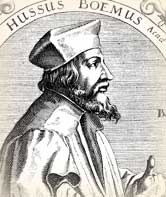The story of the Bohemian/Czech hero, Jan Hus, is one of the most heroic events of the church age.

A full century before the Reformation under Martin Luther made Germany a Protestant nation, a similar movement swept Bohemia. The Bohemian reformation was destined to collapse, however. Its noble leaders, Jan Hus and Jerome of Prague, were burned at the stake after unjust trials before the Council of Constance. Their followers, representing many conflicting interests, could not stick together because of internal squabbles.
The revolution began when Jerome of Prague visited Oxford. He returned to Bohemia carrying the teachings of John Wycliffe. The popular preacher, Jan Hus, picked up these ideas and spread the gospel according to Wycliffe. Like Wycliffe, he took the Bible for his guide and rejected certain teachings that could not be found in Scripture.
The serfs of Bohemia responded with joy, for the Bible seemed to promise a new order of liberty and equality, symbolized by their participation not just of the bread of communion, but also in the wine. Persecuted Christians, such as the Waldenses, embraced Hus' doctrine, for it was as Bible-centered as the followers of Peter Waldo had tried to be. Nobles saw church reform as a means to shake off the grip of the German invaders who ruled Bohemia at that time, and who were still Roman Catholic.
When Hus perished in a pyre of flame with a hymn on his lips, and love for Christ in his heart, the nobles of Bohemia responded with fury. On this day, September 2, 1415, an assembly of Bohemian and Moravian notables sent the Council of Constance a document signed by 500 of their prominent men, declaring they would fight to the last drop of their blood to defend what they saw as the true doctrines of Christ.
Fight they did. They butchered the anti-Hussites that King Wenceslaus packed onto Prague's New Town council. When Pope Martin V launched a crusade against them, Czechs swarmed into national armies for the defense of their homeland. Under the brilliant military leadership of Jan Zizka, they defeated several larger forces. Victorious on the field of battle, they proceeded to slaughter monks and Germans alike and tried to impose their religious views by force of arms. Most of Bohemia fell under their control.
But then the revolution disintegrated. In about twenty years, conflicting ambitions, unfulfilled promises, and lawlessness fragmented the alliance. Frightened by the chaos, much of the upper class returned to the Roman church. Even so, a breakaway church survived. The Unity of the Brethren (Moravians) held true to their beliefs amidst the chaos; and, despite fierce persecution, they refused to be stamped out.

A full century before the Reformation under Martin Luther made Germany a Protestant nation, a similar movement swept Bohemia. The Bohemian reformation was destined to collapse, however. Its noble leaders, Jan Hus and Jerome of Prague, were burned at the stake after unjust trials before the Council of Constance. Their followers, representing many conflicting interests, could not stick together because of internal squabbles.
The revolution began when Jerome of Prague visited Oxford. He returned to Bohemia carrying the teachings of John Wycliffe. The popular preacher, Jan Hus, picked up these ideas and spread the gospel according to Wycliffe. Like Wycliffe, he took the Bible for his guide and rejected certain teachings that could not be found in Scripture.
The serfs of Bohemia responded with joy, for the Bible seemed to promise a new order of liberty and equality, symbolized by their participation not just of the bread of communion, but also in the wine. Persecuted Christians, such as the Waldenses, embraced Hus' doctrine, for it was as Bible-centered as the followers of Peter Waldo had tried to be. Nobles saw church reform as a means to shake off the grip of the German invaders who ruled Bohemia at that time, and who were still Roman Catholic.
When Hus perished in a pyre of flame with a hymn on his lips, and love for Christ in his heart, the nobles of Bohemia responded with fury. On this day, September 2, 1415, an assembly of Bohemian and Moravian notables sent the Council of Constance a document signed by 500 of their prominent men, declaring they would fight to the last drop of their blood to defend what they saw as the true doctrines of Christ.
Fight they did. They butchered the anti-Hussites that King Wenceslaus packed onto Prague's New Town council. When Pope Martin V launched a crusade against them, Czechs swarmed into national armies for the defense of their homeland. Under the brilliant military leadership of Jan Zizka, they defeated several larger forces. Victorious on the field of battle, they proceeded to slaughter monks and Germans alike and tried to impose their religious views by force of arms. Most of Bohemia fell under their control.
But then the revolution disintegrated. In about twenty years, conflicting ambitions, unfulfilled promises, and lawlessness fragmented the alliance. Frightened by the chaos, much of the upper class returned to the Roman church. Even so, a breakaway church survived. The Unity of the Brethren (Moravians) held true to their beliefs amidst the chaos; and, despite fierce persecution, they refused to be stamped out.
Bibliography:
- "Bohemia" in Encyclopedia Americana. Chicago: Americana Corp., 1956.
- Curtis, A. Kenneth, et al. Dates With Destiny; the 100 most important dates in church history. Tarrytown, N. Y.: Revell, 1971.
- Durant, Will and Durant, Ariel. The Story of Civilization: The Reformation. New York: Simon and Schuster, 1950.
- Rowe, Henry K. History of the Christian People. New York: Macmillan, 1931.
- Spinka, Matthew. Jan Hus and the Czech Reform. Chicago, Illinois: The University of Chicago press, 1941.
- Various church histories and internet articles.